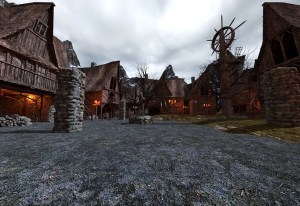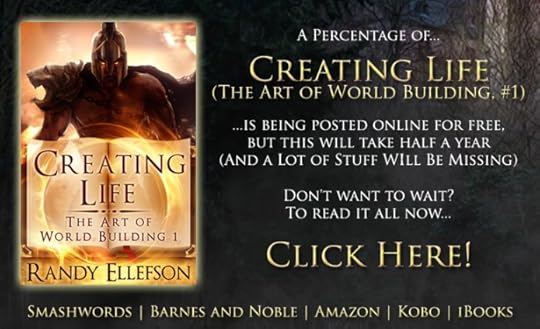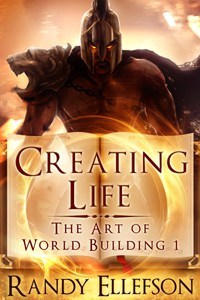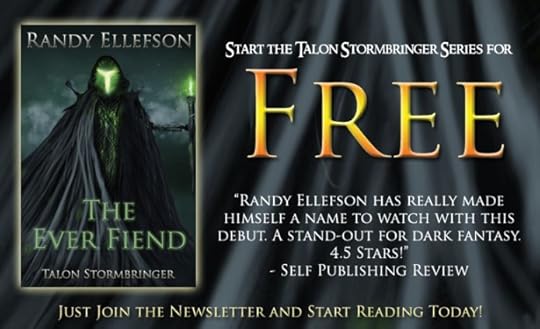Randy Ellefson's Blog, page 40
July 6, 2017
How Many Worlds Will You Build?
 How to Decide
How to DecideConsider how passionate you are about world building. If you’re an author, your primary goal is telling stories. Will you be satisfied with showing your originality in the story more than the setting? Is there a risk you’ll get so involved in world building that you’ll seldom get around to telling those stories? Authors are well known for finding excuses not to write despite wanting to write. Will this become one? Every minute on this is a minute you could’ve spent on your writing craft or building an audience. Where does your heart lie?
It’s also important to consider how long you intend your career to be. If you’re a “lifer” and will write for decades in a genre requiring world building, then expending a lot of effort makes more sense than for someone who wants to give writing a shot and will bow out after failure, or even modest success. If you know that’s you, why invest tons of time, even if you love it? Fiction is a speculative field, but writing a book at least produces a product to be sold; building a world seldom does.
Life intrudes on our time to write. This is truer for longer works like a novel. If we don’t have time to write a novel this year, because we’re in college, or just became a parent, or something else, we can spend time inventing a setting instead. A novel takes months of continuous work to stay involved, but world building can be done in a few minutes here and there. In my case, I spent most of a decade unable to write due to first college and then an injury that made writing difficult; in the meantime, I built an enormous amount for my main world. The younger me gave the older me a great gift.
How Many Worlds Are In You?
Do world builders have the ability to create more than one great world? Theoretically, yes. Do you? Creative people try to avoid repeating themselves. The more specific an idea, the more sense it makes to exclude it from a second world. Having dragons on both worlds is okay, but if the first world is dominated by dragons who only breathe fire, cast no magic, and won’t let anyone ride them, then repeating that in another world makes us look like we have no imagination; the dreaded “formula” accusation will get hurled at us. With each world created, we further restrict ourselves. Soon we’re out of ideas. We could solve that by being generic all the time, but then what’s the point of world building?
A Caveat
If the first story we publish in a world begins a series, audiences may/will expect any subsequent stories set on that planet to have some connection to that initial one. This likely originates from this being what authors frequently do. If we defy this expectation, there may be some backlash. We can avoid this expectation by publishing unrelated stories on that world before a series there. One problem with that solution is that if we’re self-publishing, it’s widely believed that our careers will do best if we publish a series because readers gobble up subsequent books, so perhaps self-publishing a few unrelated short stories or a novella gets us past all of this. Or we can just ignore the issue.

July 3, 2017
How Many Worlds?
 One Vs. Many
One Vs. ManySince world building takes time, we should consider how many worlds we might build over the course of our career and whether it makes sense to build a world per story (twenty worlds for twenty stories), just one world for all [twenty] stories, or a mixture of both. Or neither. Let’s look at the pros and cons of each approach.
One World for One Story
Creating a world for each story has some advantages. We build only what we need for that tale, so it takes less time. We don’t have to think through so many items. We’re not tied to that world indefinitely; if our audience doesn’t like it, or we grow tired of it, or something just doesn’t seem to be working, we were done with it anyway. Those creators who aren’t sure how much writing they’ll do can test the world building waters and learn if it’s something they enjoy. If we’re a novice at world building and it shows in early work, we can learn and move on rather than having to fix those mistakes. If we have a more experimental concept that takes greater risks with an audience supporting it, we’ve risked less.
This approach has disadvantages as well. Skimping on world building could cause an under-developed or less interesting world. It can be less unique, too, if we use staples like elves, dwarves, and dragons. It takes considerable work to invent species that favorably compare to those. If we do a lot of work but only use it once, is it worth it? We’ll have to repeat much of that work every time we invent another world. This could cause world building fatigue when we’re on our twentieth world. The risk of repeating ourselves also rises. If a story becomes very popular and our audience demands more, we might find that our less developed concepts have caused problems we struggle to resolve in later works.
One World for Many Stories
The alternative is to build one world for use on those twenty books. Just doing it once means not repeating ourselves. Greater depth and realism can be created by inventing more detail, which is needed to make new concepts, like species, more believable. This approach becomes worthwhile if we’ll use the setting for years. If we invent new life and use only those, we’re no longer bound by the expectations that familiar species cause. We have freedom to follow our own rules. Our books will stand out, and if the setting is popular, this alone can draw fans back with each new product released. We might even be able to license the world for product development, from action figures to role-playing spin-offs.
This much attention to detail is a considerable time investment, which The Art of World Building will reduce. We need a diverse world to avoid audience boredom over so many tales, and this requires months, even years of development. During that time, we’ll benefit from friends who are willing to provide feedback on the world we’ve created, but this is hard to get. People want to comment on a story, not on our world building. If we know other world building authors, they might help and are our best resource. If we never get published, we never reach an audience and have arguably wasted time, but having multiple stories to set in that world mitigates this, as does the ability to self-publish. Time spent on this is also time not spent on our writing craft. World building fatigue can creep in from inventing so many things, but everything is optional and some elements have higher priorities than others.
On the surface, creating one setting per book may involve less effort at the time, but if we have to create a dozen worlds over the years, is that more or less work than one more detailed, reusable setting?
The Hybrid
We can split the difference—create one planet that’s intended for many stories while also creating less developed ones for single stories. This hybrid approach is the best of both worlds. We might need a break from our “main” world (for lack of a better term) or just want to do something different or new once again. We can utilize a single-use world for more extreme risks, keeping our main world more accessible.
If we create a main world to use many times, a mixed approach will ease the upfront time investment. This is discussed in more detail in volume three, Cultures and Beyond, “Getting Started” chapter. What we can do is create our continents in rough form, then the gods of that whole world, and any species, animals, and plants that are found mostly everywhere. Then focus on a continent and some nations on the large scale and some basic history, including wars and animosities. We’ll also need a major city or two in every kingdom. At that point, we’ve created a basic framework for the rest. As needed when writing a story, we can flesh out details of any given city.
At later times, we can develop other continents, cities, and add more monsters and other creatures as we go along. If we have a new book series, we can set it on the world we’ve created but in another kingdom or continent we haven’t used much, or even in another time period. And yet we still have our species, our gods, or a system of magic. We can reuse much of what we’ve already done.

June 29, 2017
Using Analogues
 Do we really need to build a world? Only if our story takes place somewhere other than Earth. But that world can be so Earth-like that it’s essentially Earth with another name. This is the easiest approach with the lowest amount of risk. Unfortunately, it’s also the least interesting. This is what’s referred to as an analogue: something that has a corresponding version on Earth.
Do we really need to build a world? Only if our story takes place somewhere other than Earth. But that world can be so Earth-like that it’s essentially Earth with another name. This is the easiest approach with the lowest amount of risk. Unfortunately, it’s also the least interesting. This is what’s referred to as an analogue: something that has a corresponding version on Earth.
For example, maybe we invent a small island country called Xenoi where ritual suicide is accepted, honor is cherished over life, expert swordsman use special swords, women are subservient, everyone has black hair, fish and rice are diet staples, and there’s an emperor. How far did you get through that before you realized Xenoi is Japan? Which elements would you remove so that it’s not so obvious?
We should make changes to our analogues so they aren’t easily recognized.
The Rule of Three
When using an analogue, strive to change the source in at least three significant ways. Focus on the most prominent aspects and alter some, or make a longer list and decide what matters to keep and what doesn’t. If you have no specific use for a trait that really identifies the analogue, remove it.
For example, an elf lives in the forest, has pointed ears, and disrespects humans. Do we need the pointed ears? Are they serving a purpose we can’t live without? Why not ditch the negative attitude? Leaving them in forests might be good, but maybe they should be more wide ranging. This exercise can be done to everything else in this book series. Follow the rule of three and fewer people will recognize your analogues.
What’s In a Name?
More than you think.
Let’s say I invent a world that features a horse with an extra pair of legs. Next I incorporate a poisonous yellow tomato as well as a lion of superior intelligence. Then I call these objects horse, tomato, and lion. Would you remember the differences or picture the traditional versions?
There’s a kind of mental inertia to a known term; it suggests familiarity, which in turn overwrites our memory of a different detail in the book we’re reading. For example, if a horse is described as having six legs the first time it’s mentioned, but that detail never arises over the next hundred times the creature appears, readers will completely forget it has two more legs.
This issue is less true in a visual medium—we’re reminded of the difference every time the creature appears—but in books, we’ll have to keep reminding people, which feels like unnecessary exposition and housekeeping (for us and the audience). If we have to keep calling it a “six-legged horse,” that encumbrance isn’t much better. If we don’t call it a horse, but describe it in such a way that people think, “Oh, it’s just a horse with two more legs,” is that an improvement? More importantly, unless the alteration matters in some way, why do it at all? It does make the world more alien, which is a fine goal.
Another issue we can face is inappropriately using a known term. There are expectations about what a word means, and while we have some creative license to make things our own and put a new spin on something, there’s a limit to how much liberty we can take before we cause a negative reaction. An obvious example would be calling a seven-foot-tall humanoid a dwarf (unless all other humanoids are considerably taller than that). In a visual medium, we must be especially careful not to be too obvious with an analogue. I recently saw a movie where characters spoke of goblins. I formed an expectation of what I’d see. Imagine my surprise when the goblin turned out to look like a gorilla with horns and a love of gold. It even moved and behaved like a gorilla. My expectations were defied in a way that jarred me right out of the story.
These factors should be considered when deciding if we should use a different name. A new word also carries some risk. Authors may need to present a longer description to their audience. What we’re describing needs to be firmly imprinted on the reader’s mind so that little more than the term is needed later. We might use the occasional mention of a characteristic, preferably during action involving that feature so it doesn’t seem like a reminder.
World builders can decide based on how many changes we’ve made to the analogue. The more changes we’ve made, the more our creation warrants a new name. How to create names is covered in Cultures and Beyond (The Art of World Building, #3).

June 26, 2017
Why Build a World?
 Some people do it for fun, some do it for their stories, and some might do it from a sense of obligation (it’s expected in their genre), but world building is always voluntary. We can easily craft a story using standard staples like elves and dragons, castles and wizards, or anything else we’ve all seen before. But if you wanted to repeat what everyone else has done, this book wouldn’t have attracted your attention. We can be creative in more than just storytelling. We can do more than slap together a new species after only a little development time because we aren’t going to use it much or dive into details about it.
Some people do it for fun, some do it for their stories, and some might do it from a sense of obligation (it’s expected in their genre), but world building is always voluntary. We can easily craft a story using standard staples like elves and dragons, castles and wizards, or anything else we’ve all seen before. But if you wanted to repeat what everyone else has done, this book wouldn’t have attracted your attention. We can be creative in more than just storytelling. We can do more than slap together a new species after only a little development time because we aren’t going to use it much or dive into details about it.
We’ve all seen something new that made us wish we’d thought of it. We’ve all wanted our work to stand out. And who hasn’t gotten a little bored with those available, public domain ideas? They’re overused because everyone can use them. Why not create something unique, something that makes our world shine brightly?
The answer is that it’s not easy. It can be time consuming. They are so many things to consider. And if no one likes what we’ve built after countless hours of blood, sweat, and tears, we’ve wasted all of that time and effort. Failure costs us respect. People stop enjoying our work. Maybe they write a snarky review online. The more risk we take, the greater our odds of failure.
And the better our odds of being brilliant.
The Art of World Building series ensures you do the latter. It’s designed to help you avoid pitfalls and improve the quality of your ideas so you can create a memorable world that’s respected, fascinating, and a huge asset to your works. If you’re one of the lucky few, there might even be extensive merchandising opportunities if people are captivated with your world. But let’s not get ahead of ourselves or leave all of this to chance.

June 22, 2017
Introduction Conclusion (Vol. 1)
Effective world building requires having written down details about the created world. To help you organize and jumpstart your efforts, each volume in this series includes templates in the appendices. This volume includes seven: gods, species, monsters, world figures (heroes, villains, and more), plants, animals, and undead.
Rather than typing these up yourself, you can download these templates for free by joining the newsletter for The Art of World Building. As each volume is published, whether you’ve bought the book or not, subscribers will automatically receive an email with links to download the templates as Microsoft Word files, which you can repeatedly use.
Creating Places (Volume Two)
 The life we create needs to originate from somewhere on a planet: an ocean, a continent, in a land feature (like a forest or mountain range), in a kingdom, or in a settlement. Creating Places (The Art of World Building, #2) goes into detail about inventing such locations and figuring out how long it takes to travel between them by various forms of locomotion: foot, horse, wagon, dragon, wooden ship, spaceship, and more. The overall rules of our world are also considered, along with inventing time, history, various places of interest, and how to draw maps. We can start our work with any one of those subjects and crisscross between places and life, for one often impacts the other.
The life we create needs to originate from somewhere on a planet: an ocean, a continent, in a land feature (like a forest or mountain range), in a kingdom, or in a settlement. Creating Places (The Art of World Building, #2) goes into detail about inventing such locations and figuring out how long it takes to travel between them by various forms of locomotion: foot, horse, wagon, dragon, wooden ship, spaceship, and more. The overall rules of our world are also considered, along with inventing time, history, various places of interest, and how to draw maps. We can start our work with any one of those subjects and crisscross between places and life, for one often impacts the other.
Cultures and Beyond (Volume Three)
Everything not covered in the first two volumes lies within the finale, Cultures and Beyond (The Art of World Building, #3). This includes creating culture, language, religions, military groups, the supernatural, technology, magic items, names, and even mundane items like a monetary system. Much of this work ties together our life forms and places. These are the things we comment on most during a story and which our characters consider. Without them, no world building project is complete.

June 19, 2017
Chapter Summaries (Vol. 1)
What follows is a brief summary of what’s included in each chapter in volume one, Creating Life.
Chapter 1—Why Build a World?
While world building is expected in many genres of fantasy and SF, we must decide how many worlds to build. This will depend on our career plans and goals. Learn the advantages and disadvantages of building one world per story vs. one world for many stories, and when to take each approach. Sometimes doing both is best, allowing for greater depth in one world but the option to step away to keep things fresh. Using analogues can help us create believable societies quickly but has pitfalls that can be avoided. Do you have the ability to create many interesting worlds, and will they have enough depth to make the effort worth it?
Chapter 2—Creating Gods
Our species will invent gods to believe in even if we don’t invent them, so we may need some deities for people to reference in dialogue, whether praying or swearing. In SF, belief in gods may still exist despite, or even because of, advances in science. In fantasy, priests often call on a god to heal someone, and this requires having invented the gods. Pantheons offer advantages over a lone god, including dynamic relationships between them and the species. Half gods and demigods are other options that help us create myths and legends to enrich our world, especially if gods can be born, die, or be visited in their realm.
Myths about how the gods or species came to exist help people understand the purpose of their lives and what awaits them in death. Symbols, appearance, patronage, and willingness to impact the lives of their species all color a pantheon and world. Gods also create places people can visit or items that can fall into the wrong hands, offering possibilities for stories.
Chapter 3—Creating a Species
Audiences are familiar with using “race” to distinguish between humanoids, especially in fantasy, but species may be a more appropriate term. This chapter explores the meaning and implications of both words, with some examples of which one to use, when, and why.
Creating a species is challenging and time consuming, but the risks and rewards can be navigated and achieved, respectively. This chapter helps us decide on our goals and if the effort is worth it. SF writers might have little choice but to create species because there are no public domain species available like the elves, dwarves, and dragons of fantasy. The benefits of creating something different can outweigh the investment and help our work stand out.
An invented species must compete with legendary ones like elves, dwarves, and dragons; this chapter helps us achieve this. Starting with habitat helps us decide on physical adaptations that affect their minds, outlook, and society, and what a typical settlement might be like and even whether or not they live in jointly formed settlements. Their disposition affects their relationships with other species but can also limit their usefulness to us unless steps are taken to avoid this. Characteristics like intelligence, wisdom, and dexterity all play a role in how they can be used in our work, as does their society and world view, both affected by a history we can invent to integrate them with our world. Their familiarity with the supernatural and technology influences their prominence and how they compare to other life in our world.
Chapter 4—Creating World Figures
Villains, heroes, and more give our characters admired or despised individuals who’ve shaped the world and inspired them. Using Earth analogues can speed the invention of such world figures, though it’s best to change some details to obfuscate the similarities. Living figures can provide ongoing usefulness but the deceased can cast a long shadow, too. Their possessions can be just as famous and offer opportunities for our characters to find something helpful or dangerous. Family, friends, and enemies also provide ongoing possibilities for their life to impact our current characters.
Chapter 5—Creating Monsters
The difference between monsters, species, and animals is largely sophistication and numbers. Many monsters are created by accidents that turn an existing species or animal into something else, but sometimes monsters are created on purpose. In the latter case it’s especially important to decide who caused this. A monster’s habitat has an impact on its usefulness and sets the stage for creating atmosphere and characterization that will largely define our audience’s experience with it before the terrifying reveal. Its motivation in life, or in our work, also determines what it does and the sort of trouble it’s causing for our species.
Chapter 6—Creating Plants and Animals
In fantasy, creating plants and animals is optional due to expectations that the world is very Earth-like, but in SF that takes place away from Earth, audiences are more likely to expect new ones. It takes less time to create these than other life in this book, but we’ll want to consider our time investment, how often our setting will be used, whether our creations impact our work and the impression it creates, and whether the desire to do something unique and new is worthwhile for both us and our audience.
Plants and animals are classified into categories, such as cycads, conifers, and flowering plants, and amphibians, birds, fish, mammals, and reptiles. The lifecycle of the former and the behavior of the latter help distinguish them and can be used to propel or inhibit stories involving them. While we may have purposes for them as an author, our world’s inhabitants have them, too, such as decoration and medicinal uses for plants, and domestication, sports, guards, pets and transportation for animals. Both can be used for food and materials to enrich life and our world.
Chapter 7—Creating Undead
Many types of undead already exist and are public domain, and it’s challenging to invent something new. Undead are often classified by appearance and behavior, but it is also their origins and how they can be destroyed that will help distinguish our undead from pre-existing types. The two basic ones are those with a body, like zombies, and those without, like ghosts. Those with a body might have a soul or not. We can decide on the mental faculties of our undead by deciding if the mind goes with the soul, but there are other factors that can impair the minds and even emotional states of undead. All of these affect behavior, as do their origins, goals, and what they’re capable of.

June 15, 2017
About Me and Disclaimers (Vol. 1)
By profession I’m a software developer, but I’ve been writing fantasy fiction since 1988 and building worlds just as long, mostly one planet called Llurien. Yes, I am crazy. But I love what I do. I didn’t intend to work on it for so long, but when life has prevented me from writing, I’ve worked on Llurien. I’ve done everything in these chapters and authored two hundred thousand words of world building in my files. Llurien even has its own website now at http://www.llurien.com. I’ve written six novels and over a dozen short stories over the years, and have just begun my publishing career with a novella that you can read for free (see below).
I’m also a musician with a degree in classical guitar; I’ve released three albums of instrumental rock, one classical guitar CD, and a disc of acoustic guitar instrumentals. You can learn more, hear songs, and see videos at my main website, http://www.randyellefson.com.
Free Book
If you’d like to see a free sample of my own world building efforts in action, anyone who joins my fiction newsletter mailing list receives a free eBook of The Ever Fiend (Talon Stormbringer). Please note there’s also a separate newsletter for The Art of World Building, though both can be joined on the same signup form. Just check the box for each.
Disclaimers
World building is defined as the act of creating an imaginary world. While that suggests an entire planet, the result is often one continent or less. By world building, I don’t mean using pre-existing ideas and putting your own spin on them, such as reimagining Greek gods in modern or ancient times, or writing an alternate reality of Earth. While such approaches are fine, that’s not what this series is about, though such creators may still find the series useful.
I’ve omitted the science behind any real or imagined technology (like the warp drive from Star Trek) because other books on these subjects exist. While I’ve included some details to help you create life forms with appropriate features, the information is tailored to world building uses. The guide focuses on being realistic about imagining new worlds while not being overly technical. Something like plate tectonics is discussed in volume two because it impacts the formation of mountains, but the details of subduction zones are seldom relevant for us when drawing mountain ranges, for example.
While some authors prefer the term “races” to “species,” I’ve used the latter term throughout most of the series except for the section in this volume discussing the merits of both terms. This book uses “SF” to abbreviate science fiction. SF is broadly defined herein as a setting with technology far in excess of current capabilities. Fantasy is loosely defined in this book as a setting using magic, knights, and lacking modern technology. As a stylistic point, to avoid writing “he/she,” I’ve also opted for “he” when discussing someone who could be either gender.
Since I am an author, and primarily write fantasy, the series is admittedly weighted in this direction, but whether you’re in the gaming industry, a screenwriter, a hobbyist, or write science fiction, much of the three volumes can help you anyway. I just don’t claim to have covered every last element despite my attempts to be reasonably comprehensive. If you have suggested topics you feel should be covered, feel free to contact me at mail@randyellefson.com about updates for later editions.

Creating Life – Introduction
 Note: this is the start of Creating Life (The Art of World Building, #1).
Note: this is the start of Creating Life (The Art of World Building, #1).
Series like Harry Potter, Star Trek, The Lord of the Rings, and Star Wars are beloved for their intricate and detailed worlds. Each has made their creators famous, respected, and fabulously wealthy. They’ve generated billions in revenue across multiple industries, including books, movies, games, and endless merchandising. They’re part of popular culture. How can you emulate such skill? This book series, The Art of World Building, will teach you how to create believable, imaginative, and hopefully lucrative worlds to improve your fantasy or science fiction career.
My first goal with this series is to provide you with tools to speed you along in what is often time-consuming work. My second aims to help you realize your dreams and make great choices. Whether you’ve built many worlds before, are in the middle of your first one now, or have never started, this series can help you achieve your objectives by providing:
An examination of your goals, options, and how much of your attention each subject needs
Detailed advice on the pros and cons of every approach and how to balance them
Extensive research on real-world elements you should understand and utilize
How and when to use analogues
Thought-provoking questions to help you make informed decisions and stimulate imagination
Classification of world building elements into related areas for clarity
Practical examples illustrating potential results
Ideas on organizing world building files for quick access and minimized redundancy
Reusable templates to ensure consistency and thoroughness
The examples included in the text were created specifically for this guide and are not drawn from any setting I’ve created, except in rare instances. Where possible, well-known books, films, and TV shows have been cited as good examples that illustrate a point. With examples of what to avoid, I’ve usually avoided naming the work. Many of the examples and discussions herein can trigger ideas.
The book has a website where you can find additional resources and information on other volumes in this series.
Where to Start
The series, and chapters within each volume, can be read in any order but are arranged according to what might come first in a world’s timeline. Gods, if real, precede humanoids, which precede undead humanoids, et al. But our creations can be invented in any order. In fact, crisscrossing back and forth between different subjects is part of the work. We might start with inventing gods before working on species, then update our gods based on what we’ve done with species. It’s unusual, even unlikely, to invent something and then never revisit it.
Only you can decide where to begin, but it’s recommended to take any idea and run with it, writing down whatever occurs to you. If there are problems with it, they can be fixed later as you update and improve upon it. If you haven’t read a chapter in this book and have an idea for something that’s covered here, go ahead and write down everything you’re thinking. Stopping to read this might make the idea vanish. We can also get it into our heads that we must do something “right.” This is a dangerous thought because it inhibits creativity, which is the lifeblood of all art, including world building. It’s better to jot down a poor idea and fix it later than to stall, research how it could be done, get overwhelmed, and then forget it or lose interest.
Doing it “right” is itself “wrong” much of the time, as there are seldom rules that cannot be bent and even broken. All advice, whether found in this series or another, is best stated in an open-ended manner and taken as food for thought rather than as a gospel that must be followed. If you disagree with anything written here or elsewhere, good for you. Deciding not to do something, or going about it a different way, still adds clarity to our process and results.
So where do you start? Where your heart lies.





